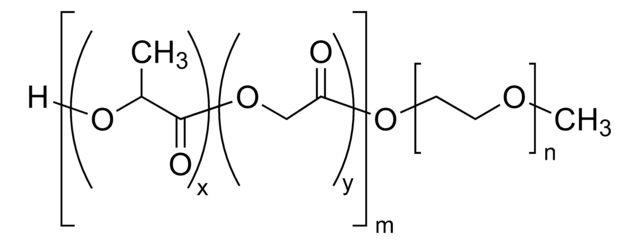570311
Poly(ethylene glycol)-block-poly(ε−caprolactone) methyl ether
PCL average Mn ~13,000, PEG average Mn ~5,000
Sinônimo(s):
Poly(ethylene glycol) methyl ether-block-poly(ε−caprolactone)
About This Item
Produtos recomendados
forma
solid
peso molecular
PCL average Mn ~13,000
PEG average Mn ~5,000
average Mn ~18,000 (total)
prazo de degradação
>12 months
pf
54.2-55.9 °C (lit.)
58.8-60.7 °C
Mw/Mn
<1.4
PDI
≤1.4
Procurando produtos similares? Visita Guia de comparação de produtos
Características e benefícios
Código de classe de armazenamento
11 - Combustible Solids
Classe de risco de água (WGK)
WGK 3
Ponto de fulgor (°F)
Not applicable
Ponto de fulgor (°C)
Not applicable
Equipamento de proteção individual
Eyeshields, Gloves, type N95 (US)
Escolha uma das versões mais recentes:
Já possui este produto?
Encontre a documentação dos produtos que você adquiriu recentemente na biblioteca de documentos.
Artigos
Professor Nicola Tirelli (Istituto Italiano di Tecnologia, Italy) highlights the microfluidic-assisted method for fabricating well-defined and reproducible nanoparticles for drug delivery research.
The development of drugs that target specific locations within the human body remains one of the greatest challenges in biomedicine today.
Professor Nicola Tirelli (Istituto Italiano di Tecnologia, Italy) highlights the microfluidic-assisted method for fabricating well-defined and reproducible nanoparticles for drug delivery research.
Humankind has utilized protein materials throughout its existence, starting with the use of materials such as wool and silk for warmth and protection from the elements and continuing with the use of recombinant DNA techniques to synthesize proteins with unique and useful properties.
Nossa equipe de cientistas tem experiência em todas as áreas de pesquisa, incluindo Life Sciences, ciência de materiais, síntese química, cromatografia, química analítica e muitas outras.
Entre em contato com a assistência técnica






